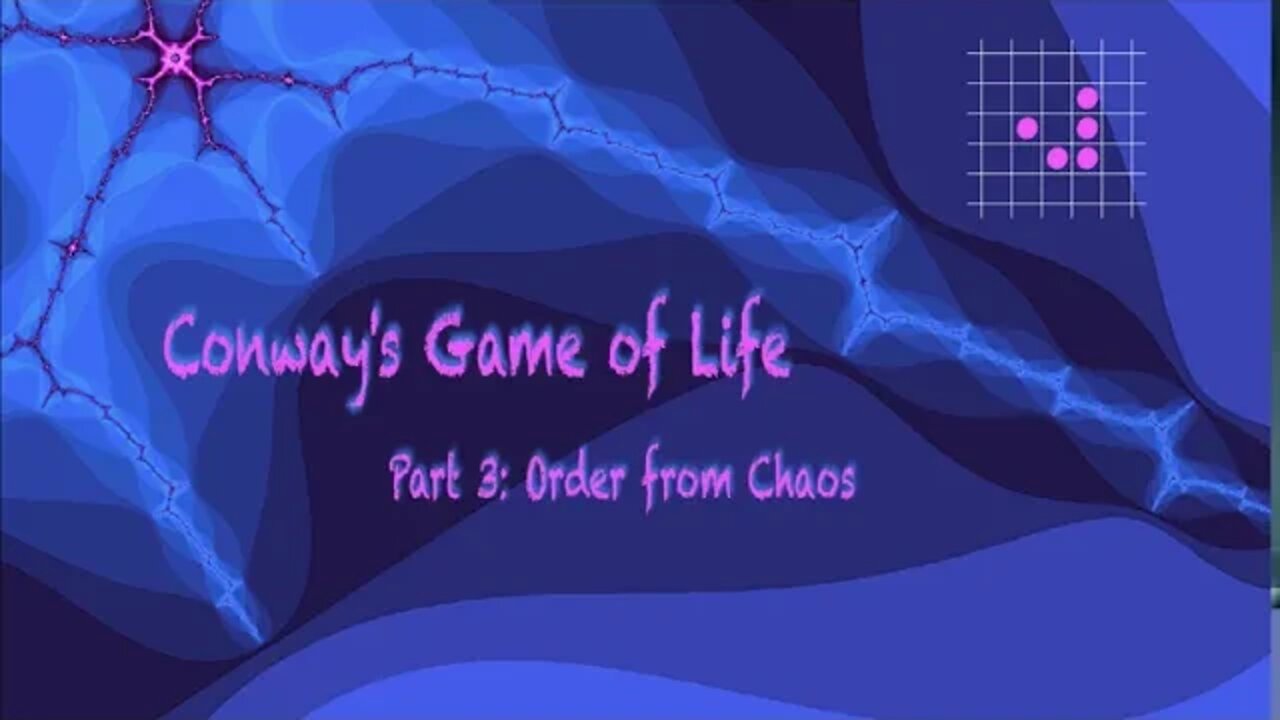Premium Only Content

Conway's Game of Life: Part 3 (Order from Chaos)
The three categories of Still Life, Oscillators and Gliders are discussed and the examples from Part 1 and Part 2 are reviewed and classified (Block, Boat, Beehive, Blinker and Glider). New configurations (or patterns) are discovered (Toad and Tub) by examining the "ash" resulting from randomly seeding a large area of cells and "igniting" them. The 2nd such experiment results in the discovery of the (Cambridge) Pulsar which was originally discovered by John Conway in 1970. The Longboat and Ship also appear.
The 2nd half of the video itemises the top ten most frequently discovered Still Life configurations in "ash experiments". Finally a similar list is displayed for the top ten most frequently discovered Oscillator patterns. This latter list also displays their behaviour and discusses the period of each configuration (eg period 2: Beacon, Clock, Bipole, Quadpole; period 3: Pulsar; period 8: Figure 8; period 15: Pentadecathlon etc)
The Game of Life is an example of a Cellular Automaton. Cellular Automata are studied in Mathematics, Computer Science, Physics and Theoretical Biology. The Game of Life was invented by the British mathematician John Horton Conway in 1970 and first published in the Scientific American Mathematical Games column written by Martin Gardner.
Other titles in this series are:
Conway's Game of Life: Part 1 (a gentle introduction / tutorial / explanation)
https://youtu.be/484FWxvO-Ro
Conway's Game of Life: Part 2 (Gliders, Crashes & Still Life)
https://youtu.be/gIRBuHkVcLc
Conway's Game of Life: Part 4 (Gliders, Spaceships and the Speed of Light)
https://youtu.be/rIEM1-pAwTI
Conway's Game of Life: Part 5 (Gosper's Gilder Gun - A Fantastic Tale of Discovery)
https://youtu.be/i6suvH2TvHg
Conway's Game of Life: Part 6 (A Chronology of Spaceship Discoveries - Glider, LWSS, 25P3H1V0, etc)
https://youtu.be/5yLcsaewxJQ
-
 7:18:24
7:18:24
SpartakusLIVE
9 hours agoSNIPING in Battlefield 6 - REDSEC || Monday MOTIVATION to CONQUER the Week
49.8K4 -
 49:25
49:25
ThisIsDeLaCruz
5 hours ago $15.14 earnedBack Stage Pass with Avenged Sevenfold
49.2K8 -
 6:43:40
6:43:40
GritsGG
10 hours agoWorld Record Win Streak Attempt! #1 Most Wins 3880+!
26K2 -
 3:12:05
3:12:05
Tundra Tactical
8 hours ago $22.59 earnedProfessional Gun Nerd Plays Battlefield 6
56.1K6 -
 1:01:12
1:01:12
Donald Trump Jr.
10 hours agoThe China Matrix with Journalist Lee Smith | TRIGGERED Ep.288
146K90 -
 11:56:00
11:56:00
Dr Disrespect
15 hours ago🔴LIVE - DR DISRESPECT - ARC RAIDERS - FULL SEND INTO THE RED
164K18 -
 5:17:51
5:17:51
JdaDelete
6 hours ago $0.43 earnedFinally playing Eldin Ring | First Playthrough Episode 2
13.4K4 -
 1:02:08
1:02:08
BonginoReport
9 hours agoNicki Minaj Speaks Out Against Christian Persecution - Nightly Scroll w/ Hayley Caronia (Ep.169)
69.6K54 -
 5:23:36
5:23:36
HomieQuest
8 hours agoLive Streaming! Pokemon Legends Z-A
5.34K4 -
 5:33:02
5:33:02
FusedAegisTV
11 hours agoFUSEDAEGIS PLAYS THE GREATEST JRPG EVER MADE ⌛► CHRONO TRIGGER (1995) Part 3
4.46K3